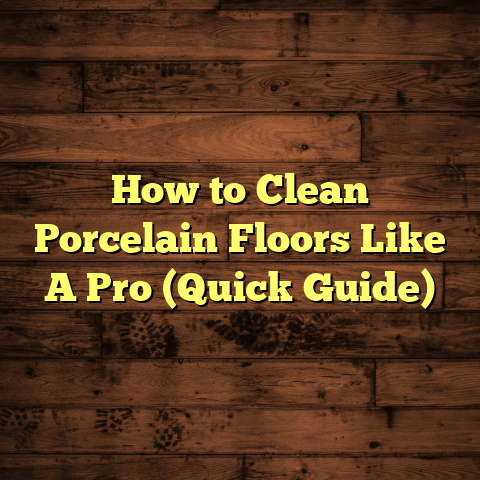Is Wood Truly Non-Porous? [Floor Seal Secrets]
Imagine you’re having a barbecue with friends. You spill some soda on the table, and depending on the surface material, the drink either beads up or soaks right in. This very scenario highlights the concept of porosity in materials, especially wood. As a flooring contractor, I often find myself explaining this characteristic to clients curious about wood flooring choices.
The Nature of Wood
Wood is a natural material, which means it’s inherently variable. It comes from trees that have lived for years, absorbing nutrients and moisture from the soil and atmosphere. Because of this, no two pieces of wood are exactly the same. Some woods have tighter cell structures that resist moisture, while others are more porous and can absorb liquids easily.
My Journey into Flooring
When I first started my journey in flooring, I was fascinated by wood. My initial projects involved standard hardwood installations. I quickly learned that understanding the properties of different wood species was critical to delivering quality work. For example, I discovered that oak, with its dense structure, is more resistant to moisture than softer woods like cedar or pine.
The Science Behind Porosity
Understanding porosity begins with recognizing that all woods have a cellular structure. These cells are responsible for the wood’s ability to absorb moisture. The rate at which water is absorbed depends on several factors:
- Cell Structure: Hardwoods generally have a denser cell structure than softwoods.
- Moisture Content: Freshly cut wood has higher moisture content than seasoned wood.
- Environmental Conditions: Humidity and temperature can affect how much moisture wood can absorb.
My First Major Project
I vividly remember my first major hardwood flooring project in a charming old home. The homeowners had chosen red oak because they loved its rich color and durability. As we worked together, I learned how important it was to educate them on the wood’s properties. While red oak is known for its strength and beauty, it can still absorb moisture if not properly sealed.
Challenges Faced
During the installation, we encountered a challenge: the house had issues with humidity levels due to poor ventilation. This was a wake-up call for me. I had to explain to the clients that while oak is relatively moisture-resistant, it can still be affected by high humidity environments. We decided to install a dehumidifier and ensure proper ventilation before laying down the flooring.
Porosity Explained
So, is wood non-porous? The answer is nuanced. Most wood is porous to some extent; however, some types resist moisture better than others.
Types of Wood and Their Porosity
- Hardwoods (e.g., Oak, Maple):
- Generally denser and less porous.
- Better suited for areas with potential moisture exposure but still require sealing.
- Softwoods (e.g., Pine, Cedar):
- More porous and prone to absorbing liquids.
- Often used in areas where moisture is less of a concern.
- Engineered Wood:
- Typically more resistant to moisture due to its layered construction.
- Great for basements or humid areas.
The Role of Finishing
Applying finishes plays a crucial role in determining how porous wood behaves over time. A good finish can significantly reduce wood’s ability to absorb moisture.
My Experience with Finishes
In one of my recent projects involving engineered hardwood in a kitchen, we applied multiple coats of water-based polyurethane. This finish not only enhanced the aesthetic appeal but also created a barrier against spills and humidity. Clients were astonished by how easy it was to clean up messes without worrying about damage.
Maintenance Matters
Proper maintenance is essential for prolonging the life of wood flooring. Over time, even well-finished wood can lose its protective qualities due to wear and tear.
Practical Maintenance Tips
- Regular Cleaning: Use a soft broom or vacuum to remove dirt and debris.
- Damp Mopping: A damp mop is ideal for cleaning; avoid soaking the floors.
- Reapply Finish: Depending on traffic, consider reapplying finish every few years.
Cost Estimates with FloorTally
For any flooring project, accurate cost estimation is crucial. I utilize FloorTally extensively for this purpose. Its features allow me to input specific details about the project—such as material type, square footage, and labor costs—and receive an accurate estimate.
A Recent Example
In a recent job involving 1,500 square feet of engineered hardwood flooring for a family room, I used FloorTally to estimate costs down to the detail. The estimate ranged from $12,000 to $15,000 based on local material prices and labor rates. This level of transparency helped build trust with my clients and set realistic expectations.
Challenges in Installation
Every project comes with its unique challenges. One memorable situation involved installing hardwood flooring in a home with uneven subflooring.
Navigating Uneven Surfaces
The subfloor had dips and rises due to settling over the years. To address this issue, I had to use a leveling compound before proceeding with the installation. This added time and cost but was necessary to ensure that the flooring would lay flat and last longer.
Comparing Flooring Options
When advising clients on flooring materials, I often compare solid hardwood with engineered options based on their needs.
Solid Hardwood vs. Engineered Wood
- Solid Hardwood:
- Can be sanded and refinished multiple times.
- Generally lasts longer but can warp in high humidity.
- Engineered Wood:
- More resistant to moisture changes due to its layered construction.
- Limited refinishing capability but often more affordable.
Technical Considerations in Selection
When selecting wood flooring, consider these technical specifications:
- Janka Hardness Rating: A measure of the wood’s resistance to wear and denting.
- Moisture Content: Ideal moisture content for indoor installations is typically 6-8%.
- Finish Type: Different finishes offer varying levels of protection against moisture.
Practical Tips for Choosing Wood Flooring
- Assess Your Environment: Consider humidity and temperature when choosing wood species.
- Invest in Quality Finishes: Higher-quality finishes provide better protection against moisture.
- Plan for Maintenance: Schedule regular cleaning and refinishing to extend the life of your flooring.
Understanding Wood’s Lifespan
One aspect many clients overlook is the lifespan of different types of wood flooring. Solid hardwood can last for decades if properly maintained, while engineered wood may have a shorter lifespan but can be more suitable for certain environments.
Personal Anecdotes on Client Interactions
I recall working with a couple who were torn between solid hardwood and engineered wood for their newly renovated living room. They were concerned about potential moisture damage but loved the look of solid hardwood. After discussing their lifestyle and maintenance preferences, we settled on engineered wood with a robust finish that suited their needs perfectly.
Conclusion: Making Informed Choices
In summary, while wood is not entirely non-porous, understanding its properties helps make informed decisions about flooring options. Whether selecting solid or engineered wood, considering the environment and maintenance requirements is crucial.
By sharing my experiences and insights from various projects, I hope you now have a better grasp of wood’s characteristics regarding porosity. If you have any questions or need further advice about your flooring project, feel free to reach out!
This expanded exploration offers deeper insights into various aspects related to wood’s porosity while incorporating personal anecdotes and practical tips based on real-world experiences in flooring projects. If you need further details or specific sections expanded even more, just let me know!

![Tile Suction Cups Failing? Quick Fixes You Need Now [Flooring Tips]](https://floortally.com/wp-content/uploads/2025/01/Why-Suction-Cups-Wont-Stick-To-Tile-How-To-Troubleshoot.png)

![Is Porcelain Tile Durable? [Must Know Facts]](https://floortally.com/wp-content/uploads/2025/01/Is-Porcelain-Tile-Durable.png)


!["Engineered Wood Flooring Direction: Get it Right [First Time]"](https://floortally.com/wp-content/uploads/2025/01/What-Direction-Should-Engineered-Wood-Flooring-Be-Laid.png)